High Altitude Tips – Bolivia
Whether it is the French or Austrian Alps for skiing, the magnificent Mount Fuji in Japan, the rugged peaks of Corsica, or closer to home Ben Nevis on the western coast of Scotland I have always loved the mountains. The Andes of Bolivia is one such mountain range that has so far managed to elude me but rest assured it will be conquered! Someone who has managed to enjoy them is Caroline Joyner from the Travel Counsellors. There was however an issue that she had to overcome – altitude sickness. Here she gives her advice and high-altitude tips on how best to alleviate the problem.
There is no doubt that much of the Andes of South America will leave you breathless but not just by way of its beauty.
Survival Tips
It was a bumpy landing at 6.30 am at the world’s highest international airport and my wonderful Bolivian agent was waiting to meet me. “Buenos Dias y Bienvenido a La Paz” he said merrily. I, on the other hand, wasn’t feeling particularly merry after a night flight. In my Product Manager role, I was tasked with 2 weeks of research which would take me to do some of Bolivia’s highlights, from its sprawling altitude Capital to the scenic shores of the world’s highest navigable lake, to the low-lying tropical cloud forest.
Landing at El Alto airport in La Paz is a somewhat interesting experience. To start with, the descent is noticeably short. One minute the tips of mountains are all around you and the next you are touching down. High altitude airports need longer runways and El Alto’s is 4km long. This is apparently because the lower pressure at a higher altitude means less air resistance to stop. We landed at what seemed an incredibly high speed and it took a long time to slow down.
So there I was at 4060m and my sea-level-living body was not happy.
Who Is Most Affected?
You don’t need to be climbing a mountain to experience high-altitude sickness. Altitude sickness is by its nature a very individual thing and this is an important point. Some people feel far less affected than others. During my time in Latin America’s high-altitude cities and mountains I have experienced trekking with people who barely feel it and those who are virtually debilitated by it. I am somewhere in between but leaning towards the debilitating side. Altitude sickness has little to do with fitness, weight, age or lifestyle – it strikes in what appears to be an entirely random fashion. Add that to the fact that just because you felt it on one trip you may not feel it on the next and you’ve got yourself a curve ball effect. The only thing we know for sure is that good acclimatisation is essential.
Walking off the plane and through the airport, I felt very strange, weak, heavy and tired. At first, though these symptoms can easily be confused with jet lag, especially after a night flight. A quick taxi ride and then an exhilarating cable car ride brought us down to a more respectable 3600m in the downtown area where I was deposited in my hotel to sleep for a few hours before starting work. As I lay down to sleep I could feel my heart pounding in my chest. Heading out later into the chaotic streets of La Paz every breath felt laboured.
Over the next few days, I had many meetings and this required hot-footing it around La Paz’s maze of hilly streets. Walking uphill felt as if I was carrying at least a 20kg backpack. My head veered between a haze and a blinding headache. Sleep was restless and my dreams were vivid but confused. My mouth was so dry it felt like the world’s worst hangover. As you can imagine none of these contributed to the professional demeanour I was hoping to conjure. I arrived at each meeting unable to speak with breathlessness, gulping water down and running for the nearest toilet.

What Is Altitude Sickness?
Descent to lower altitude is the only cure for moderate or acute AMS. If you are ascending a mountain and begin to feel confused, dizzy, nauseous, breathless at rest, have heart palpitations or begin to cough phlegm you must descend immediately.
So what is altitude sickness? Altitude sickness, or AMS (Acute Mountain Sickness), occurs at altitudes of over 2500m, although generally symptoms are felt at over 3000m. Symptoms occur due to the decrease in atmospheric pressure which means the body can take in less oxygen. At 3,600 metres (12,000 feet) there are roughly 40% fewer oxygen molecules per breath so the body must adjust to having less oxygen.
However what causes symptoms of AMS is when you ascend too high too quickly, for example when flying. If the body is given enough time, it can to adjust to the decreased oxygen at a specific altitude which is known as acclimatisation. The most important basic rule for climbers, trekkers and mountaineers is, therefore, to ascend slowly.
Acclimatisation takes from 1-3 days generally but is necessary for each increase in altitude. Mild AMS, which is what I experienced in La Paz, is very common. Acute AMS takes 2 forms and can be fatal in rare cases.
High Altitude Tips
Coca tea is the first of my high altitude tips as its mild stimulating effect, aids with the symptoms of altitude sickness. The Coca plant is native to western Latin America and is famous throughout the world on account of its psychoactive alkaloid which when extracted and processed chemically becomes the base of cocaine. Don’t panic, it’s legal!
The amount of alkaloids present in the raw coca leaf is very small; actually, it’s minute in comparison with the amount of alkaloids contained in a line of cocaine. Drinking the tea, therefore, does not produce any type of narcotic high, although the growth of Coca in Bolivia has been controversial for a long time.
Indigenous president Evo Morales has faced a long-running battle with the US and would like to see it eradicated but the Coca Leaf is a large part of the local economy, and millions of rural families survive by growing and trading it for medicinal and traditional use. Chewed by Andean workers for centuries, coca leaves are now synonymous with Bolivian culture.
Sickness Pills
Sorojchi (Spanish for altitude sickness) pills are Bolivian-made, sold in every pharmacy, in La Paz and pretty much all high-altitude tourist spots in Latin America. They contain aspirin, caffeine and a type of paracetamol so they are only treating the symptoms rather than the cause, but they did work for me.
Altitude can mess with your sleep as the decreased oxygen supply means your breathing is shallower. Paracetamol or natural remedies such as melatonin can help you stop continually waking. People also say sleeping on your left side helps increase oxygen intake.
So what other high-altitude tips are there that you can do when catapulting your body from low to high altitude in a plane is the only option?

Recommendations
Acclimatisation is the key – Give yourself 1-2 days at a high altitude before doing any activities. Avoid increasing your sleeping altitude by more than 300m per night without acclimatising first.
Keep well hydrated – Your digestive system works more slowly at altitude and water helps it along, as does a high-fibre diet. If you are flying in then one of the best high altitude tips is to drink lots and eat light meals on the plane.
Take it easy for the first 24 hours – Your body needs rest to produce more red blood cells which are needed to carry oxygen around the body. Walk slowly and take short breaks often.
Exercise before setting off– This can help increase your lung capacity.
Eat light, easily digestible meals – Eating several smaller meals is best.
Avoiding alcohol and smoking is pretty much a recommendation whatever the issue.
Sleep low – This mainly applies to trekking but for example, in La Paz, the Zona Sur is around 500m below the Downtown area and this can help if you are susceptible to AMS.
Try not to fly at high altitudes, overland transport or walking is best!

Contact Information
With thanks to Caroline Joyner from the Travel Counsellors for her high altitude tips. If you are interested in a holiday to Bolivia or any part of South America please get in touch with her on the details below.
T: 07801 591350
E: caroline.joyner@travelcounsellors.com



















